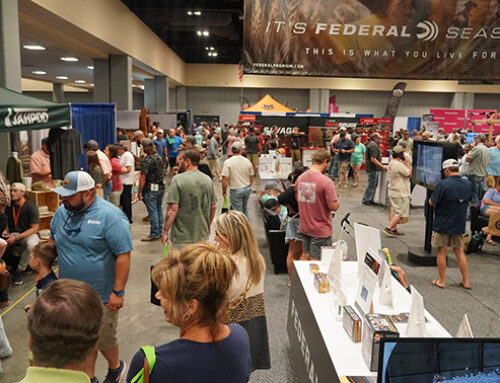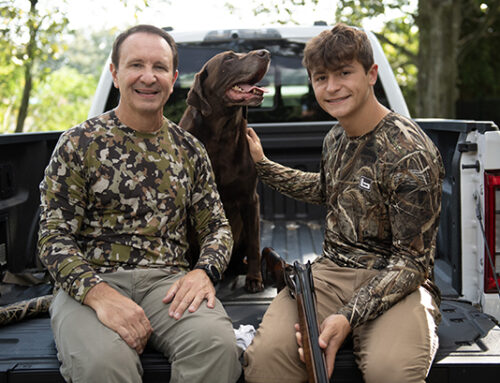2020 Goose Outlook: Honkers and Specks Thriving

If hunting giant Canada geese is your favorite fall activity, it might be advisable to buy a couple extra boxes of magnum steel shot and make sure your honker decoys are ready for hard use.
Resident Canada goose populations are thriving, especially in the north-central United States. Hunters will benefit with longer seasons and generous daily bag limits designed to target abundant — and even overabundant — locally nesting geese.
That’s certainly the situation in North Dakota, where the state’s breeding waterfowl census reported 335,000 nesting Canada geese, a 6 percent increase from 2019, and the third-highest breeding population on record there. Even better news: Coupled with good snowpack and a wet spring, goose production is strong.
“There’s a lot of Canada geese,” said Michael Szymanski, migratory game bird supervisor for the North Dakota Game and Fish Department. “We had water in the seasonal basins, and recorded the sixth-highest wetland index this spring. Canada goose production was good across eastern North Dakota, and most of the northwest part of the state. It was likely a Top 3 production year for geese.”
Ideal conditions extended beyond North Dakota borders, too. South Dakota reportedly had excellent goose production, and other Midwestern states also are reporting a favorable hatch.
Although Wisconsin wasn’t able to conduct the state’s annual breeding waterfowl index because of Covid-19 concerns this year, all indications are that Canada geese had excellent reproductive success again in the Badger State. In 2019, Wisconsin estimated 171,407 Canada geese, a number that almost certainly would have been higher had the 2020 index occurred.
“I have been both traveling across the state on banding trips for ducks and communicating with the public and staff, and 2020 looks like an exceptional year for local goose production,” said Taylor Finger, migratory game bird ecologist for the Wisconsin Department of Natural Resources. “The water levels, spring conditions and weather all looked like it was a great spring for Canada geese. Our expectation is that things are going to be looking good for the upcoming hunting seasons.”
Goose production reports coming out of Canada are less positive. In fact, white goose hunters might be facing another season reminiscent of the 2018-2019 campaign, during which snow goose flocks contained nearly all adult birds. The 2020 breeding season for mid-continent snow geese is expected to be bust, with very few goslings produced.
Frank Baldwin, wildlife biologist for the Canadian Wildlife Service, said weather conditions in the Eastern Arctic were poor for goose reproduction.
“Spring was quite late this year, with 40 centimeters (about 16 inches) of snow still on the ground in the second week of June,” he said. “It was a late, cold spring, so things do not look good in the Eastern Arctic for light goose production.”
Baldwin also pointed to what he termed “awful rains” that hit Baffin Island during a critical hatching period for snow geese. Baffin Island, located north of the Arctic Circle in Nunavut, is a critically important nesting colony area for snow geese.
Baldwin’s report comes with an important caveat: Because of the threat of bringing Covid-19 to native communities, researchers were not allowed into key nesting areas in the far north, so most goose population studies and banding work simply did not occur there this summer. As a result, biologists have very little data on this year’s hatch. That said, arctic weather conditions in 2020 mirrored those of 2018, which was a terrible year for light goose production.
In the 2020 Waterfowl Population Status Report released by the U.S. Fish & Wildlife Service in August, the population estimate for mid-continent lesser snow geese declined by 14 percent, or 1.57 million geese. Still, the population remains abundant at 9.92 million geese. Ross’s geese were also down 37 percent over 2019 estimates.
The outlook is better for Central Arctic regions, according to Baldwin. In northern Manitoba, banding crews marked 20 percent juvenile snow geese, albeit in a very small sample size of 500 birds. There too, spring was late in arriving. Baldwin said the smaller races of cackling and Canada geese that breed in the region were likely affected by colder, wetter weather than that of a typical spring. Below average production is expected.
In brighter news, the mid-continent population of white-fronted geese, a.k.a. specklebellies, is estimated at 1.27 million, a healthy 64 percent increase over 2019. No 2020 estimate was available for the Pacific Population of whitefronts, but 2019 population of 479,000 is strong, and speck hunters from Louisiana to California should be in for a good season.
Brant populations on both coasts remain stable. The Atlantic brant population is estimated at 140,000, a 16 percent increase over 2019, while the Pacific brant number 143,000, which is down 12 percent.
Overall, most populations of geese in North America are healthy. Migrating flocks of the northern-most nesting species — such as lesser snow geese and cacklers — are likely to contain mostly adult birds this season. Meanwhile, if you hunt giant Canada geese, expect a lot of juvenile birds. The flight forecast is truly a mixed bag for the 2020-21 hunting season.
The best advice? When the goose season opens in your area, gather your gear and go hunting. You can’t shoot ’em from the couch. — Paul Wait






I have owned a cabin on the Delaware Bay south of Dover for 29 years and kept a nature journal throughout all those years . In early November the large V- formations of geese flew all night long and filled the sky by the thousands — Typically in November, the evening sky was filled with migrating flocks . This year I have seen three small flocks of less than a dozen birds each.
How many Geese are there? Like in the world